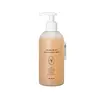What's inside
What's inside
 Key Ingredients
Key Ingredients

 Benefits
Benefits

 Concerns
Concerns

 Ingredients Side-by-side
Ingredients Side-by-side

Water
Skin ConditioningSodium Laureth Sulfate
CleansingCocamidopropyl Betaine
CleansingSodium Chloride
MaskingParfum
MaskingPolysorbate 20
EmulsifyingPEG-80 Sorbitan Laurate
Tetrasodium EDTA
Citric Acid
BufferingDMDM Hydantoin
PreservativeSodium Hydroxide
BufferingPropylene Glycol
HumectantCI 19140
Cosmetic ColorantCI 16035
Cosmetic ColorantBlue 1 Lake
Cosmetic ColorantCoumarin
PerfumingGeraniol
PerfumingLimonene
PerfumingLinalool
PerfumingCitronellol
PerfumingBenzyl Salicylate
PerfumingWater, Sodium Laureth Sulfate, Cocamidopropyl Betaine, Sodium Chloride, Parfum, Polysorbate 20, PEG-80 Sorbitan Laurate, Tetrasodium EDTA, Citric Acid, DMDM Hydantoin, Sodium Hydroxide, Propylene Glycol, CI 19140, CI 16035, Blue 1 Lake, Coumarin, Geraniol, Limonene, Linalool, Citronellol, Benzyl Salicylate
Water
Skin ConditioningGlycerin
HumectantCentella Asiatica Leaf Water
Skin ConditioningCoco-Betaine
CleansingPotassium Cocoyl Glycinate
Dipropylene Glycol
HumectantAcrylates Copolymer
Propanediol
SolventIsopentyldiol
HumectantSodium Dna
Skin ConditioningMadecassoside
AntioxidantSalmon Egg Extract
Portulaca Oleracea Extract
Skin ConditioningHouttuynia Cordata Extract
Skin ConditioningCamellia Sinensis Leaf Water
MaskingCoptis Japonica Root Extract
Skin ConditioningGardenia Florida Fruit Extract
Skin ConditioningTheobroma Cacao Extract
Skin ConditioningSilybum Marianum Seed Extract
Skin ConditioningPersea Gratissima Fruit Extract
EmollientAllium Cepa Bulb Extract
Skin ConditioningMaltodextrin
AbsorbentDextrin
AbsorbentPentylene Glycol
Skin ConditioningButylene Glycol
HumectantEthylhexylglycerin
Skin ConditioningPotassium Cocoate
EmulsifyingMethylglucamine
Potassium Benzoate
PreservativeC12-14 Alketh-12
EmulsifyingParfum
Masking1,2-Hexanediol
Skin ConditioningWater, Glycerin, Centella Asiatica Leaf Water, Coco-Betaine, Potassium Cocoyl Glycinate, Dipropylene Glycol, Acrylates Copolymer, Propanediol, Isopentyldiol, Sodium Dna, Madecassoside, Salmon Egg Extract, Portulaca Oleracea Extract, Houttuynia Cordata Extract, Camellia Sinensis Leaf Water, Coptis Japonica Root Extract, Gardenia Florida Fruit Extract, Theobroma Cacao Extract, Silybum Marianum Seed Extract, Persea Gratissima Fruit Extract, Allium Cepa Bulb Extract, Maltodextrin, Dextrin, Pentylene Glycol, Butylene Glycol, Ethylhexylglycerin, Potassium Cocoate, Methylglucamine, Potassium Benzoate, C12-14 Alketh-12, Parfum, 1,2-Hexanediol
Ingredients Explained
These ingredients are found in both products.
Ingredients higher up in an ingredient list are typically present in a larger amount.
Parfum is a catch-all term for an ingredient or more that is used to give a scent to products.
Also called "fragrance", this ingredient can be a blend of hundreds of chemicals or plant oils. This means every product with "fragrance" or "parfum" in the ingredients list is a different mixture.
For instance, Habanolide is a proprietary trade name for a specific aroma chemical. When used as a fragrance ingredient in cosmetics, most aroma chemicals fall under the broad labeling category of “FRAGRANCE” or “PARFUM” according to EU and US regulations.
The term 'parfum' or 'fragrance' is not regulated in many countries. In many cases, it is up to the brand to define this term.
For instance, many brands choose to label themselves as "fragrance-free" because they are not using synthetic fragrances. However, their products may still contain ingredients such as essential oils that are considered a fragrance by INCI standards.
One example is Calendula flower extract. Calendula is an essential oil that still imparts a scent or 'fragrance'.
Depending on the blend, the ingredients in the mixture can cause allergies and sensitivities on the skin. Some ingredients that are known EU allergens include linalool and citronellol.
Parfum can also be used to mask or cover an unpleasant scent.
The bottom line is: not all fragrances/parfum/ingredients are created equally. If you are worried about fragrances, we recommend taking a closer look at an ingredient. And of course, we always recommend speaking with a professional.
Learn more about ParfumWater. It's the most common cosmetic ingredient of all. You'll usually see it at the top of ingredient lists, meaning that it makes up the largest part of the product.
So why is it so popular? Water most often acts as a solvent - this means that it helps dissolve other ingredients into the formulation.
You'll also recognize water as that liquid we all need to stay alive. If you see this, drink a glass of water. Stay hydrated!
Learn more about Water